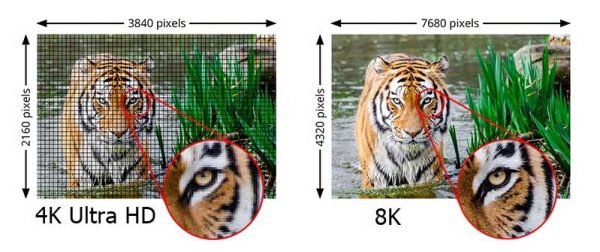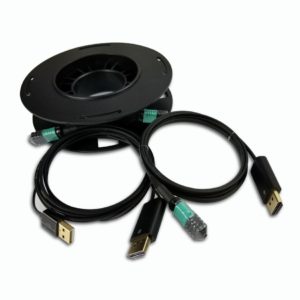How and why HDMI became the gold standard in broadcasting
High-definition multimedia interface (HDMI) was founded in 2002 by industry leaders in electronics and entertainment, among them Panasonic, Sony, and Toshiba. It quickly won support from major motion picture producers like Fox, Universal, Disney, Warner, and others. HDMI has dramatically improved the television experience. The technology is evolving as enhancements are added to newer versions. Aside from tv sets, HDMI technology can be found in camcorders, computer monitors, and digital still cameras. It has broad business applications.
Released in 2013, HDMI 2.0 quickly caught on, particularly after the introduction of ultra-high-definition television which requires more bandwidth for higher resolution, greater clarity, and faster frame rates. 2.0 also introduced 3D capabilities and smoother synchronization between audio and video.
HDMI 2.1 was introduced a few years ago (2017) but was not installed in tv sets until late 2018. The newer version provides enhanced performance and certain quantifiable improvements.
Which version is right for you? Here’s what you need to know.
HDMI 2.0 vs. HDMI 2.1 Pros and Cons
HDMI 2.0 Advantages
- High bandwidth (to a maximum of 18.0 Gbps)
- 4K resolution gives picture increased clarity
- Supports 32 audio channels
- Supports dual video streams: you can view two different HD shows on the same screen simultaneously
- Widely available: found on most television sets manufactured since 2013 including Sony, LG, Samsung and others
- Supported by PS5 and Xbox Series X up to 4K at 60 frames per second
- Less Expensive than 2.1
HDMI 2.0 Disadvantages
- Does not support certain gaming applications
- Not suitable for content requiring smooth motions, such as video games
HDMI 2.1 Advantages

- Greater bandwidth: 48 Gbps compared to 18 Gbps for 2.0 which means Improved video performance
- Features like Variable Refresh Rate (VRR) adjust your display in real time to help eliminate stuttering and lag
- Wider color gamut
- Faster frame rates (up to 120 frames per second)
- Resolution up to 10K means improved support for commercial audiovisual, industrial and specialty uses
- Reduced delay switching between video sources
- Suitable for next-gen gaming on consoles like PS5 and Xbox Series X
HDMI 2.1 Disadvantages
- Requires an HDMI-2.1 compatible tv or monitor – which translates to a more limited audience at present as only high-end newer television sets support it
- Requires an HDMI 2.1 cable but cables are backwards compatible with 2.0 configurations or ports
- More expensive
Vitex HDMI 2.0/2.1 Products
Vitex is an industry leader in supplying fiber optics products to businesses in the United States. Fiber optics is preferred particularly in business applications as it gives clearer resolution over long distances with less interference and enhanced network security.
We currently carry these HDMI products:
LightBolt Pure Fiber HDMI 2.0 Extender – LH0-201
This pure fiber extender comes with HDMI pigtails connected to both ends of a fiber optic cable providing for easy assembly and installation, supporting ultra high definition monitors. Data can be transmitted upto a 1000ft.
LightBolt HDMI 2.0 Active Optical Cable (AOC) – LBV-0ITH20001
Our pre-tested hybrid HDMI cables are available in a variety of lengths. We can also customize the length to meet your specific needs.
Introducing our HDMI 2.1 product line
LightBolt X-Link All-in-One Extender – LXL-301-TR
LightBolt X-Link is a customizable KVM extender that allows users to transmit audio, video, USB and ethernet signals on a single fiber optic cable while delivering pure signal integrity at exceptional speeds. Accommodates HDMI 2.1 or DisplayPort for high-definition video.
LightBolt Pure Fiber HDMI 2.1 Extender
Our HDMI 2.1 extender is easy to install and provides beautiful clarity of picture and resolution, color enhancement and variety, 3D, clearer audio, and other great features. Contact us for more information.
Conclusion
HDMI 2.0 moved audiovisual technology forward dramatically in the last decade, establishing a strong presence and improving the viewer experience. It is also widely available as it has been installed in the majority of television sets sold.
HDMI 2.1 is a newer technology that represents a step forward in audiovisual technology. Although now mostly only available to the general public in higher-end newer model tvs, it does feature enhanced features, including improved video performance and audio quality. Additional improvements include smooth and seamless motions and transitions for gaming, movies, and video, higher bandwidth, and higher resolutions; these translate to greater detail and clarity and more support particularly for immersive viewing, gaming, virtual reality, and industrial, business, or scientific applications including medical imaging. As with any technological improvement, we expect its audience and uses to expand in the future as it becomes more available and is further refined.
Vitex has specialized in fiber optics products for two decades. We have engineering know-how and extensive product knowledge. We also offer customized solutions and technical support. For more information about these products or to discuss your product needs, email us at info@vitextech.com.
Related Products


